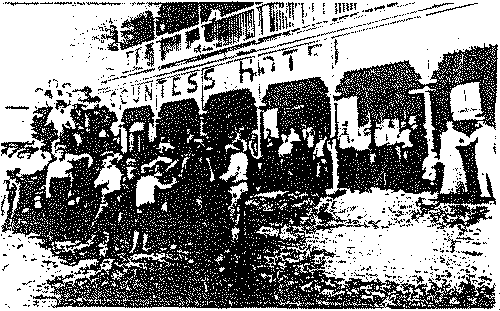I
have Jack Kennedy's account of his journey, written sixty years later as
an old man, with a magnifying glass and the strong Brisbane sunlight to guide
his pen. On the fourth day of the journey he had left his camp at Trekelano
Well and had ridden west past the Trekelano copper deposit, which he thought
too poor to peg, and on northwards another ten miles to a rocky hill which
he climbed. Resolving to examine an outcrop he had seen the previous day,
he picked his way through thick turpentine scrub and emerged onto open grassland.
At once he saw a jutting band of rock as green as the hills of Galway. With
some excitement he pegged the ground and hurried to Cloncurray where he showed
his samples to old Ernest Henry and applied for a lease. The veteran prospector
accompanied him back to Devoncourt, and with Alexander Kennedy they visited
the new mine and enthused over its richness.
The Kennedys called the mine the Duchess,
not for the purpose of attracting English investors but in honour of a well-known
lady of the west. She was the black mistress of St. John de Satgé
of Rochdale Station, an Englishman of aristocratic mien, whose remoured descent
from the French nobility earned him the title of "the Duke". She ran away
from him and arrived at Devoncourt on her master's ridinghorse just as the
Kennedys were slecting a name for their mine. "As we have a Duchess amongst
us," said old Kennedy, "we must give the mine her name." So it became the
Duchess.
Ernest Henry and Alexander Kennedy each took a three eighth interest in the
mine, and Jack and his mate Jack McKellar , a nephew of William Orr, had
an eighth interest each and did the work. Hindered by long drought and the
low price of copper, and forced sometimes to cart water from a soak twelve
miles away, they mined no ore till 1904 and only about 100 tons in the following
years. Meanwhile Henry had tried to sell the mine for £2.000 but an
English engineer named Rutherford pronounced it too rich to persist in depth.
Then in 1906, the year of the buoyant copper prices, an agent of Orr, Schlapp,
and Knox bought the Duchess for £15.000, and Jack Kennedy and Jack McKellar
went exultingly to Melbourne for the Cup and paid for their trip back by
selling another mine to a city syndicate.
"I was in my twenty-fourth year when I found
the Duchess," wrote Jack Kennedy. "I am in my eighty-fourth now and if I
had to life my life over (as Gordon the Poet says) I would go straight back
out there again." So would thousands of others if they knew that they would
find a mine as rich as the Duchess, for it yielded over £2.000.000 in
copper when the mineral was less than a third of its present price, and it
proved to be the richest mine on the old Cloncurray field.
|

